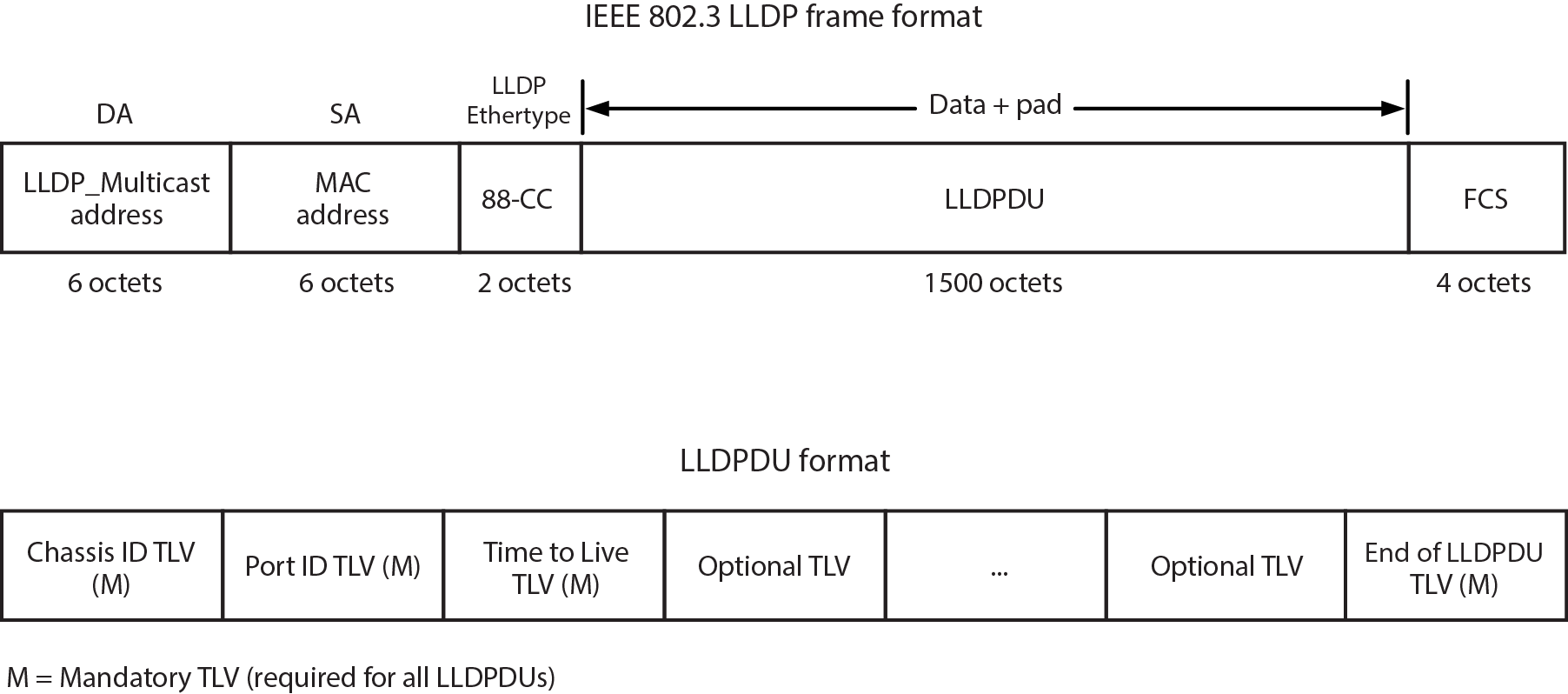LLDPDU Frames
As shown in Frame Format, each LLDPDU frame contains the following mandatory TLVs:
- Chassis ID — The chassis identification for the device that transmitted the LLDP packet.
- Port ID — The identification of the specific port that transmitted the LLDP packet. The receiving LLDP agent joins the chassis ID and the port ID to correspond to the entity connected to the port where the packet was received.
- Time to Live — The length of time that information contained in the receive LLDP packet will be valid.
- End of LLDPDU — Indicates the final TLV of the LLDPDU frame.
Each LLDPDU frame can also contain the following optional TLVs:
- Port Description — The port from which the LLDP agent transmitted the frame.
- System Name — The system‘s administratively assigned name.
- System Description — Includes the system‘s name, hardware version, OS level, and networking software version.
- System Capabilities — A bitmap that defines the primary functions of the system. The currently defined capabilities include, among other things, WLAN access point, router, and telephone.
- Management Address — The IP or MAC address associated with the local LLDP agent that may be used to reach higher layer entities.
An LLDPDU frame can also contain the following extension TLVs:
- 802.1 VLAN extension TLVs describe attributes associated with VLANs:
- Port VLAN ID — Allows a bridge port to advertise the port‘s VLAN identifier (PVID) that will be associated with untagged or priority tagged frames it receives.
- Port & Protocol VLAN ID — Allows a bridge to advertise whether it supports protocol VLANs and, if so, what VLAN IDs these protocols will be associated with.
- VLAN Name — Allows a bridge to advertise the textual name of any VLAN with which it is configured.
- Protocol Identity — Allows a bridge to advertise the particular protocols that are accessible through its port.
- 802.3 LAN interface extensions TLVs describe attributes associated with the operation of an 802.3 LAN interface:
- MAC/PHY Configuration/Status — Advertises the bit-rate and duplex capability of the sending 802.3 node, the current duplex and bit-rating of the sending 802.3 node, and whether these settings were the result of auto-negotiation during link initiation or manual override.
- Power-Via-MDI — Advertises the power-via-MDI capabilities of the sending 802.3 node.
- Link-Aggregation — Advertises whether the link is capable of being aggregated, whether it is currently in an aggregation, and, if it is in an aggregation, the port of the aggregation.
- Maximum Frame Size — Advertises the maximum supported 802.3 frame size of the sending station.
- LLDP-MED extension TLVs:
- Capabilities — Indicates the network connectivity device‘s capabilities.
- Network Policy — Used to configure tagged/untagged VLAN ID/L2 priority/DSCP on LLDP-MED endpoints (for example, IP phones).
- Location Identification — Provides the location identifier information to communication endpoint devices, based on the configuration of the network connectivity device it is connected to.
- Extended Power via MDI — Enables advanced power management between LLDP-MED endpoints and network connectivity devices.
- Inventory Management — Includes hardware revision, firmware revision, software revision, serial number, manufacturer name, model name, and asset ID.
Some TLVs support multiple subtypes. For example, Port ID is sent as an ifName (e.g., ge.1.1) between Extreme Networks devices, but when an LLDP-MED endpoint is detected on a port, that TLV subtype changes to a network address (MAC address), and other MED TLVs are sent, as defined by the MED spec.


 Print
this page
Print
this page Email this topic
Email this topic Feedback
Feedback